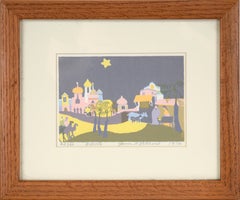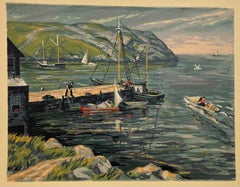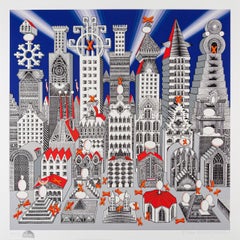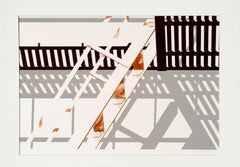Printer's Ink Landscape Prints
to
2
1
1
Overall Width
to
Overall Height
to
5
5
5
2
2
2
1
2
1
1
1
1
2
1
1
138
2,570
1,159
295
288
2
2
Style: Modern
Medium: Printer's Ink
"Nativity" Modernist Landscape Screen Print in Ink on Paper -
Located in Soquel, CA
"Nativity" Modernist Landscape Screenprint in Ink on Paper
Whimsical modern landscape silkscreen print of the nativity scene by San Francisco, C...
Category
1970s Modern Printer's Ink Landscape Prints
Materials
Paper, Printer's Ink, Screen
$452 Sale Price
20% Off
"Pond" Original Lithograph by Sally Warner 1988
Located in Soquel, CA
Detailed lithograph of a California Sierras pond and reflections by California author and artist Sally Warner (American, B- 1946). Sally Warner grew up in Connecticut and Californi...
Category
1980s Modern Printer's Ink Landscape Prints
Materials
Printer's Ink, Laid Paper, Lithograph
$1,080 Sale Price
20% Off
Related Items
Harry Shokler, Island Harbor
Located in New York, NY
Harry Shokler used serigraphy to great advantage in this landscape. It's colorful and detailed.
It is signed in the image at the lower left. When printmakers began making serigraphs...
Category
1940s American Modern Printer's Ink Landscape Prints
Materials
Screen
"Ciudad de un millón" contemporary neobarroque arquitecture city blue landscape
Located in Ciudad de México, MX
The repetition of patterns and rhythm is present in almost every piece of Pedro´s work.
The hybrid topographies that Pedro Friedeberg´s unclassifiable practice recreates we must rec...
Category
21st Century and Contemporary Contemporary Printer's Ink Landscape Prints
Materials
Digital, Paper, Ink, Screen
$2,100
H 29.14 in W 29.14 in
Paris Café with Eiffel Tower France Limited Edition Print by British Artist
Located in Preston, GB
Paris Café with Eiffel Tower France Limited Edition Print of Figurative Cityscape Painting by Leading British Urban Landscape Artist, Angela Wakefield.
Print measures 16 x 9.5 inch...
Category
2010s Contemporary Printer's Ink Landscape Prints
Materials
Paper, Printer's Ink, Archival Paper, Giclée, Color, Digital
$320 Sale Price
20% Off
H 9.5 in W 16 in D 0.1 in
DISCOVERY OF GOLD - Very Large Serigraph - WPA Artist - California Murals
Located in Santa Monica, CA
ANTON REFREGIER (1905 – 1979)
DISCOVERY OF GOLD, 1949. Color serigraph. Signed and numbered in pencil, edition of 90. Image 23 ¼ x 21 ¾" Large sheet, 29 3/4 x 25 ¼”. Printed title...
Category
1940s American Modern Printer's Ink Landscape Prints
Materials
Screen
$1,250
H 23.5 in W 21.75 in
Modernist Silkscreen Screenprint 'El Station, Interior' NYC Subway, WPA Artist
Located in Surfside, FL
screenprint printed in color ink on wove paper. New York City subway station interior.
Anthony Velonis (1911 – 1997) was an American painter and designer born in New York City who helped introduce the public to silkscreen printing in the early 20th century.
While employed under the federal Works Progress Administration, WPA during the Great Depression, Velonis brought the use of silkscreen printing as a fine art form, referred to as the "serigraph," into the mainstream. By his own request, he was not publicly credited for coining the term.
He experimented and mastered techniques to print on a wide variety of materials, such as glass, plastics, and metal, thereby expanding the field. In the mid to late 20th century, the silkscreen technique became popular among other artists such as Robert Rauschenberg and Andy Warhol.
Velonis was born into a relatively poor background of a Greek immigrant family and grew up in the tenements of New York City. Early on, he took creative inspiration from figures in his life such as his grandfather, an immigrant from the mountains in Greece, who was "an ecclesiastical painter, on Byzantine style." Velonis attended James Monroe High School in The Bronx, where he took on minor artistic roles such as the illustration of his high school yearbook. He eventually received a scholarship to the NYU College of Fine Arts, into which he was both surprised and ecstatic to have been admitted. Around this time he took to painting, watercolor, and sculpture, as well as various other art forms, hoping to find a niche that fit. He attended NYU until 1929, when the Great Depression started in the United States after the stock market crash.
Around the year 1932, Velonis became interested in silk screen, together with fellow artist Fritz Brosius, and decided to investigate the practice. Working in his brother's sign shop, Velonis was able to master the silkscreen process. He reminisced in an interview three decades later that doing so was "plenty of fun," and that a lot of technology can be discovered through hard work, more so if it is worked on "little by little."
Velonis was hired by Mayor LaGuardia in 1934 to promote the work of New York's city government via posters publicizing city projects. One such project required him to go on a commercial fishing trip to locations including New Bedford and Nantucket for a fortnight, where he primarily took photographs and notes, and made sketches. Afterward, for a period of roughly six months, he was occupied with creating paintings from these records. During this trip, Velonis developed true respect and affinity for the fishermen with whom he traveled, "the relatively uneducated person," in his words.
Following this, Velonis began work with the Public Works of Art Project (PWAP), an offshoot of the Civil Works Administration (CWA), where he was assigned to serve the different city departments of New York. After the formation of the federal Works Progress Administration, which hired artists and sponsored projects in the arts, he also worked in theater.
Velonis began working for the federal WPA in 1935. He kept this position until 1936 or 1938, at which point he began working in the graphic art division of the Federal Art Project, which he ultimately led. Under various elements of the WPA program, many young artists, writers and actors gained employment that helped them survive during the Depression, as well as contributing works that created an artistic legacy for the country.
When interviewed in December 1994 by the Library of Congress about his time in the WPA, Velonis reflected that he had greatly enjoyed that period, saying that he liked the "excitement" and "meeting all the other artists with different points of view." He also said in a later interview that "the contact and the dialogue with all those artists and the work that took place was just invaluable." Among the young artists he hired was Edmond Casarella, who later developed an innovative technique using layered cardboard for woodcuts.
Velonis introduced silkscreen printing to the Poster Division of the WPA. As he recalled in a 1965 interview: "I suggested that the Poster division would be a lot more productive and useful if they had an auxiliary screen printing project that worked along with them. And apparently this was very favorably received..."
As a member of the Federal Art Project, a subdivision of the WPA, Velonis later approached the Public Use of Arts Committee (PUAC) for help in "propagandizing for art in the parks, in the subways, et cetera." Since the Federal Art Project could not be "self-promoting," an outside organization was required to advertise their art more extensively. During his employment with the Federal Art Project, Velonis created nine silkscreen posters for the federal government.
Around 1937-1939 Velonis wrote a pamphlet titled "Technical Problems of the Artist: Technique of the Silkscreen Process," which was distributed to art centers run by the WPA around the country. It was considered very influential in encouraging artists to try this relatively inexpensive technique and stimulated printmaking across the country.
In 1939, Velonis founded the Creative Printmakers Group, along with three others, including Hyman Warsager. They printed both their own works and those of other artists in their facility. This was considered the most important silkscreen shop of the period.
The next year, Velonis founded the National Serigraph Society. It started out with relatively small commercial projects, such as "rather fancy" Christmas cards that were sold to many of the upscale Fifth Avenue shops...
Category
1980s American Modern Printer's Ink Landscape Prints
Materials
Screen
Stewart Wheeler, Atlantic City (New Jersey)
Located in New York, NY
The little that is know about the painter and printmaker Stewart Wheeler indicates that most of his career was spent in Philadelphia, Pennsylvania. And...
Category
Mid-20th Century American Modern Printer's Ink Landscape Prints
Materials
Screen
Quicksilver Royal Mail and The Blenheim
Located in Douglas, Isle of Man
James Pollard 1792-1867, was an English painter and watercolourist. Pollard was born in North London he was the son of a painter and publisher. He exhibited at the Royal Academy, Suf...
Category
1820s Printer's Ink Landscape Prints
Materials
Paper, Printer's Ink, Watercolor
Original "Wagon Lits" pop art style serigraph travel by train poster
Located in Spokane, WA
Original “Wagon Lits” serigraph poster by the artist Valerio Adami.
It was printed in France by GrafiCaza (Michel Caza), one of the finest serigraph companies on woven paper—in exce...
Category
1990s American Modern Printer's Ink Landscape Prints
Materials
Screen
$260 Sale Price
20% Off
H 36 in W 24 in D 0.05 in
La Fete a Honfleur
Located in San Francisco, CA
This artwork, "La Fete a Honfleur" c.1980 is a original colors serigraph on Wove paper by French artist (Fanch) Francois Ledan, born 1949. it is hand signed an...
Category
Late 20th Century Modern Printer's Ink Landscape Prints
Materials
Screen
The Greek Chapel of The Holy Sepulchre
Located in London, GB
First edition lithograph
Full plate: 4
Presented in a acid free mount
Modern hand-coloured lithograph for the first edition of David Roberts' The Holy Land.
Published by F.G. Moon &...
Category
1840s Realist Printer's Ink Landscape Prints
Materials
Laid Paper, Lithograph
Parisian Café Eiffel Tower Paris France Limited Edition Print by British Artist
Located in Preston, GB
Parisian Café Eiffel Tower Paris France Limited Edition Print by British Artist. A high quality limited edition print of Angela's European Series, incorporating the Eiffel Tower - on...
Category
2010s Realist Printer's Ink Landscape Prints
Materials
Paper, Printer's Ink, Archival Paper, Giclée, Digital
$320 Sale Price
20% Off
H 10.5 in W 16 in D 0.2 in
Girl at the Docks
Located in San Francisco, CA
This artwork titled "Girl at the Docks" c.1980, is an original colors serigraph by noted Italian artist Nicola Simbari, 1927-2012. It is hand signed and numbered 76/150 in pencil by ...
Category
Late 20th Century Modern Printer's Ink Landscape Prints
Materials
Screen
Previously Available Items
S.F. Fire Escape - Geometric Pattern Lithograph
Located in Soquel, CA
Modern lithograph of a geometric, abstracted San Francisco fire escape by George Dombek (American, b.1944). Hand signed and dated "Dombek '78" lower right. Titled "S.F. Fire Escape" lower left and numbered "23/30" center. Tag on verso from the Boston Printmakers 31st National Exhibition lists the artist as George Dombek. Presented in a new white mat. Unframed. Image size: 17"H x 23"W.
In the late 1970s, fresh out of college with an architectural degree, watercolorist George Dombek, of Fayetteville, Arkansas, gained recognition with his patterned studies of San Francisco fire escapes. When he moved to Ohio to teach at Youngstown State University in 1979, his attention turned to steel mills. While teaching at Florida A&M University in Tallahassee, tobacco barns...
Category
1970s American Modern Printer's Ink Landscape Prints
Materials
Paper, Printer's Ink
Printer's Ink landscape prints for sale on 1stDibs.
Find a wide variety of authentic Printer's Ink landscape prints available on 1stDibs. While artists have worked in this medium across a range of time periods, art made with this material during the 21st Century is especially popular. If you’re looking to add landscape prints created with this material to introduce a provocative pop of color and texture to an otherwise neutral space in your home, the works available on 1stDibs include elements of blue, purple and other colors. There are many well-known artists whose body of work includes ceramic sculptures. Popular artists on 1stDibs associated with pieces like this include Cynthia MacCollum, Kind of Cyan, John Stoll, and Arthur Millier. Frequently made by artists working in the Impressionist, Modern, all of these pieces for sale are unique and many will draw the attention of guests in your home. Not every interior allows for large Printer's Ink landscape prints, so small editions measuring 0.01 inches across are also available




